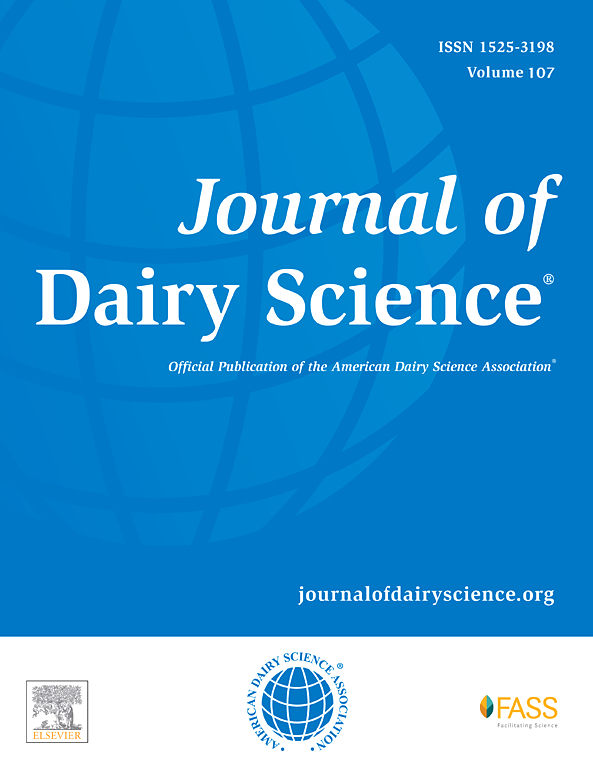An economic evaluation of sensor-assisted health monitoring in dairy farming using the example of a rumen bolus
IF 3.7
1区 农林科学
Q1 AGRICULTURE, DAIRY & ANIMAL SCIENCE
引用次数: 0
Abstract
The study investigates the economics of sensor-assisted dairy health management and indicates a certain economic potential in the use of a commercial rumen bolus capable of tracking activity and core body temperature. The economic evaluation was performed applying a stochastic model with the net return (NR) of investment of the sensor system as the target variable. The calculated NR considers the gross margin (GM) for both sensor-assisted and visual health monitoring, time savings through sensor-assisted monitoring, additional time spent addressing false positive messages from the sensor system, labor costs, and all costs associated with the investment in the sensor system. The analysis relies on a dataset acquired from a dairy research and demonstration farm on which 65 dairy cows were equipped with the sensor system. A comparison of health-related messages issued by the rumen bolus with disease diagnoses shows that the sensor system issued a message in 7 of 11 cases of retained placenta (sensitivity = 64%), in 19 of 31 cases of clinical hypocalcemia (sensitivity = 61%), in 30 of 70 cases of mastitis (sensitivity = 43%), in 6 of 24 cases of metritis (sensitivity = 25%), and in 2 of 42 cases of diseases of the locomotor system (sensitivity = 5%) in a defined observation period, in many cases several days before the visual diagnosis. SimHerd (A/S Viborg, Denmark) was applied to determine the GM as a function of incidence, SCC, risk of a mild case of disease, and days of milk withdrawal. In a workshop, veterinarians (n = 9) used the dataset to assess the effect of using the sensor system on these parameters. The empirical distributions given by the veterinarians' individual assessments were used to model the parameters considered in the calculation of the “sensor-assisted” GM. For the modeled Holstein herds with a milk yield of 9,000 kg, simulation results show that average NR of investment ranges from +€23 to +€119/cow per year for a herd of poor health, from −€12 to +€84/cow per year for a herd of average health, and from −€33 to +€63/cow per year for a herd of good health, depending on the scenario. The assumptions made regarding changes in labor had a strong influence on the calculated NR of investment. For a full economic evaluation of the sensor system, other functions (estrus detection, calving detection) and functional extensions (e.g., monitoring rumination) have to be considered.
以瘤胃丸为例,对奶牛养殖中传感器辅助健康监测的经济评价。
该研究调查了传感器辅助奶牛健康管理的经济学,并指出了能够跟踪活动和核心体温的商业瘤胃丸的使用具有一定的经济潜力。采用随机模型,以传感器系统的投资净收益(NR)为目标变量进行经济评价。计算出的NR考虑了传感器辅助和视觉健康监测的毛利率(GM)、通过传感器辅助监测节省的时间、处理传感器系统误报信息所花费的额外时间、人工成本以及与传感器系统投资相关的所有成本。该分析依赖于从一个奶牛研究和示范农场获得的数据集,该农场有65头奶牛配备了传感器系统。比较与健康有关的消息发布的与疾病诊断表明,瘤胃丸中的传感器系统发布消息7 11例保留胎盘(敏感性= 64%),在19个31例临床血钙过少(敏感性= 61%),70年30例乳腺炎(敏感性= 43%),在6的24例子宫炎(敏感性= 25%),和2 42例运动系统疾病(敏感性= 5%)定义观察期间,在许多情况下,几天前的视觉诊断。采用SimHerd (A/S Viborg, Denmark)测定转基因与发病率、体细胞计数、轻度发病风险和停乳天数的关系。在一个研讨会上,兽医(n = 9)使用数据集评估使用传感器系统对这些参数的影响。经验分布由兽医的个体被用来评估模型中考虑的参数计算的通用“sensor-assisted”。建模黑白花牛羊群的牛奶产量9000公斤,仿真结果表明,平均NR的投资范围从+ 23 +€119€每年每头牛一群健康状况不佳,从12到+€€84每年每头牛一群平均健康,和从——€33 +€63每年每头牛一群健康、这取决于具体情况。关于劳动力变化的假设对计算的投资NR有很大的影响。为了对传感器系统进行全面的经济评估,必须考虑其他功能(发情检测、产犊检测)和功能扩展(例如监测反刍)。
本文章由计算机程序翻译,如有差异,请以英文原文为准。
求助全文
约1分钟内获得全文
求助全文
来源期刊

Journal of Dairy Science
农林科学-奶制品与动物科学
CiteScore
7.90
自引率
17.10%
发文量
784
审稿时长
4.2 months
期刊介绍:
The official journal of the American Dairy Science Association®, Journal of Dairy Science® (JDS) is the leading peer-reviewed general dairy research journal in the world. JDS readers represent education, industry, and government agencies in more than 70 countries with interests in biochemistry, breeding, economics, engineering, environment, food science, genetics, microbiology, nutrition, pathology, physiology, processing, public health, quality assurance, and sanitation.
 求助内容:
求助内容: 应助结果提醒方式:
应助结果提醒方式:


